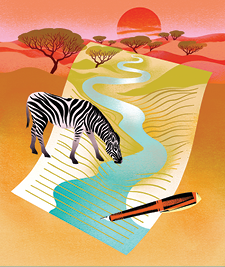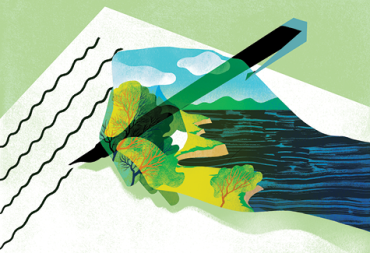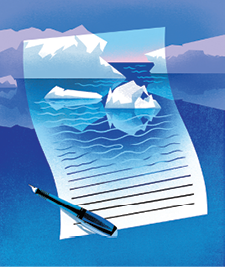With every sunrise and rotation of the earth, humans are more interconnected through reading and writing. We are using more tools for communicating than ever before, creating increasing opportunities for people across the globe to share, organize, and solve all kinds of problems, from attacks on democracy to a warming planet. These changes have moved the role of the English teacher to center stage. Humans have always been storytellers, and it has long been known that those who tell the stories control the future. It is by critically understanding the messages and engulfing them, and learning the skills to take action, that our students can create alternate discourses to change the present and shape the future. As English teachers, we have the ability and responsibility to excite, inspire, and empower students to recognize this potential and become involved in the issue of our age, climate change and environmental justice.
Our planet has already irrevocably changed as a result of human-made emissions of carbon dioxide, methane, and other gases. Today, in line with predictions made for decades, we are seeing increasing temperatures, dramatic weather swings, devastating droughts, wildfires, huge storms, flooding, sea-level rise, warming and acidic oceans, enormous animal and plant extinctions, and more.1 Our planet has warmed at least 1 degree Celsius (1.8 degrees Fahrenheit) since the pre-industrial period, with 2016—the year we wrote Teaching Climate Change to Adolescents: Reading, Writing, and Making a Difference, from which this article is excerpted—the hottest year in recorded history.
Recorded research indicates that global temperatures may increase by 4 degrees Celsius (7.2 degrees Fahrenheit) as early as the 2070s and perhaps even sooner.2 A rise of 4 degrees Celsius would permanently devastate U.S. food production, not to mention food production in other countries. The Antarctic and Greenland ice sheets have already begun to melt and break apart. No matter what humans do now, sea levels are going to rise, and rise substantially. Much of Florida and the East Coast of the United States will first be subjected to storm surges, and then inundated, as will many of the largest cities in the world.3
There is no going back. Each gallon of gasoline burned represents 100 tons of ancient plants4 and the carbon they captured being returned to the atmosphere. When carbon dioxide is released into the air, it continues to affect the climate for hundreds, even thousands, of years. We are currently on the trajectory to 4 degrees Celsius and more. It is imperative to change what we are doing and limit temperature rise to 2 degrees Celsius. It is not certain that even with focused world attention on greenhouse gas reduction that 2 degrees is still possible. For the sake of the human race and life on earth, we must, nonetheless, do all within our power to limit global warming as much as possible and as soon as possible. As one of the world’s most influential climate scientists puts it, “the difference between two and four degrees is human civilization.”5
Whatever happens, climate change will be the defining feature of the world our students inhabit. Addressing climate change is everyone’s responsibility, and that includes English teachers.
We and our students can and must make a difference. We have the opportunity and obligation to educate our students about climate change; fire their imaginations, their talents, and their energies; inform our local and larger communities; and join with others across the globe to demand and participate in one of the largest and most urgent transitions in human history.
The Urgency of Climate Change
In a simple model, humans impact the climate by releasing gases that accumulate in the atmosphere and bounce solar energy back to the earth, as in a greenhouse, making the earth grow continually warmer. Indeed, our planet is absorbing a lot of heat, warming all ecological systems. Scientists have calculated that in recent years, the earth has been gaining as much heat every day as would be released by 400,000 Hiroshima atomic bombs.6 Human emissions cause the increased warming, and natural feedback loops speed it up even faster. Ice and snow reflect 70 percent of solar energy, while the open ocean absorbs 95 percent. So as polar ice caps melt and expose more oceans, a great deal more heat is absorbed and global warming is accelerated “naturally.” Warming by human emissions releases methane, a greenhouse gas, from tundra and ocean beds, again accelerating warming.
Global warming will have a devastating impact in every country. Current understanding indicates that a catastrophic world of mass starvation, mass flooding, mass migration, and mass death of hundreds of millions, perhaps billions, of people may happen much sooner than most expect, particularly in developing countries. An entire lake in Bolivia, which was twice the size of Los Angeles, is now bone dry, resulting in residents having to flee. The largest city in the western hemisphere with 20 million residents, Sao Paulo, Brazil, is close to running out of water. Due to rising sea levels, many of the Marshall Islands and coastal regions of Bangladesh are under water or soon will be.
Some of the first to suffer and endure the worst effects will be the poorest countries, nations that have the least responsibility for the pollution that causes climate change. Poorer countries and poorer people have fewer resources to defend themselves, so the impacts of climate change will be unfair and unbalanced. The U.S. military considers climate change a threat multiplier that will cause hunger and disease, increase instability, undermine governments, and intensify conflicts and terrorism. It is already doing so in the Middle East and Africa. While climate change will be disastrous for the poorest regions of the world, it will also have horrific consequences for wealthy countries, the United States included.
We know about Hurricane Dorian in the Bahamas, Hurricanes Harvey and Maria in Houston and Puerto Rico, Hurricane Katrina in New Orleans, Superstorm Sandy in New York and New Jersey, droughts and wildfires in southeastern Texas and western states, and polar vortices in the Midwest and Northeast. And we are only at 1 degree Celsius above average so far. There are displaced Americans and refugees from drought-caused conflict in Syria, Africa, and Central America in our communities and in our schools who have climate disaster and climate refugee stories to tell. English students can investigate and help tell these local stories.
Global warming is a topic that should and does matter to young people. A survey by the Yale Program on Climate Change Communication found that the vast majority of parents (79 percent) support teaching climate change in schools.7 Yet, the education students do receive is limited. While 57 percent of teens understand that climate change is caused by human activities, only 27 percent say they have learned “a lot” about global warming in school.8
If, in the public sphere, informed and reasoned discussion about climate change does not always take place, in our classrooms we and our students can openly inquire into new realities, engage in civilized discussion, and imagine and begin to enact change. Students can script and rehearse conversations with family or friends who may be less knowledgeable. As young people work to inform others, new understandings and behavior can come about quickly through social and new media, and through our students’ modeling of behavior and enthusiasm.
Our students can learn about and consider joining young people’s efforts to address climate change. Since we wrote our book, the American Sunrise Movement has begun to mobilize young people. In October 2018, 15-year-old Greta Thunberg, at first alone, engaged in a “school strike” climate protest in her native Sweden. As her protest became an example, thousands, then millions, of middle school and high school students worldwide joined her and started an ongoing school strike movement.9
Climate Change in English Language Arts
English language arts students are transported across the globe, back in time, and into the future as they engage with the imaginations of poets, playwrights, novelists, journalists, advertisers, filmmakers, lyricists, and the best storytellers the world has encountered. English classrooms are spaces of discovery, possibility, and participation where students learn to empathize with experiences of people like and unlike themselves. They are places of moral and ethical reflection about new ideas and complicated human realities. In English language arts classes, students can read about the devastating effects of global warming, comprehend its human-made causes, and understand the creative ways people in all corners of the globe are responding to this challenge. And it is also in this space of possibility where students can learn to write with many tools to express their ideas, voice their concerns, and contribute to the environmental justice movement.
Learning to critically read their world, English language arts students can draw on informational texts and documentaries to understand climate change and examine portrayals of the effects of climate change in literary, nonfiction, and media texts. They can critically examine the influence of human economic, political, agricultural, transportation, and housing systems impacting ecological systems. ELA students can explore creative utopias and dystopias, climate fiction, and film to imagine the social consequences of the climate crisis as well as different futures and a safe, healthy, just, and environmentally sustainable world. Students need to be critical of the claims that deny the science, skeptical of the people who assert nothing can be done, and empowered to act with the kind of courage we have seen in the past when humans have risen together against overwhelming odds.10
We believe that a purely science-oriented approach to climate change can miss the social, historical, ethical, and human realities that are critical to the problem. Climate change is an accelerator that exacerbates economic, racial, and social inequality. The study of English language arts involves understanding the experience of others, including those experiencing the climate emergency, through language, texts, and media. Professor Pieter Maeseele11 explains that framing climate change primarily in the discourse of science limits consideration of the politics of how humans understand and relate to the environment and to each other, and how and whose voices are heard.
Fostering civic engagement can also shift the overall focus of English from positioning students as autonomous individuals or consumers set apart from the world to students as social participants whose ways of being and acting directly affect the local and global ecology.12 This shift involves redefining academic success based less on individual achievement and test scores and more on one’s social and collaborative relationships with others and how our actions can contribute to sustainability and environmental justice.
As teachers of English, we offer a specific perspective and a set of values for teaching about climate change. Our approach emerges from an understanding of the Anthropocene era in which we now live, when environmental, geological, and ecological systems are profoundly altered by human activity. Our beliefs are based in world citizenship, the rights and well-being of all, and the recognition of connections between the diverse members of the world family.
Adopting this climate change perspective involves:
- Foregrounding the climate crisis as the most important issue facing life on earth.
- Understanding the causes and effects of climate change locally and globally, as well as the efforts to deny them.
- Overcoming individualism and nationalism, and adopting a system-based, global perspective.
- Creating solidarity with the oppressed and exploited, addressing the unequal impacts of climate change, and striving for social justice.
- Envisioning and enacting transformational changes through individual and collective action, in which everyone is accountable for their actions and inactions.
Challenges Teachers Face
There are plenty of pressures on English teachers that make it challenging to develop and implement new ideas and new curriculum. Our book includes examples of English teachers describing their efforts to meaningfully address climate change in their classrooms.
Many states have adopted the Common Core State Standards (CCSS) for English language arts,13 which for the most part are not content based but skills based. That is, the standards do not require specific curriculum, specific literary works, specific topics, or specific themes. As the introduction states, “A great deal is left to the discretion of teachers.” Part of the very idea of the CCSS is to free teachers and curriculum developers to identify meaningful, engaging content that will raise academic and intellectual expectations. Climate change can provide this kind of content.
Instruction about climate change relates to a number of the CCSS anchor standards. The standards encourage bringing more “informational texts” into English classes. They emphasize close and careful reading, persuasive writing, and developing arguments. They expect students to “demonstrate the cogent reasoning and use of evidence that is essential to both private deliberation and responsible citizenship in a democratic republic.” In English language arts, the standards explicitly foster an integrated model of literacy, using research, developing technology and media skills, and understanding other cultures and perspectives. The standards encourage an understanding of literacy across disciplines and, when appropriate, building bridges between content areas—climate change offers many opportunities for this type of interdisciplinary teaching.
Another challenge that English teachers confront is obtaining the texts they need to do the teaching they believe in. Our book provides classroom-tested examples of a wide variety of current materials, including climate fiction short stories and novels, “informational texts,” young adult fiction, film, documentaries, websites, and so on. (For examples of short stories, see a related article here.) We share stories about entire English language arts courses devoted to climate change as well as significant units on the subject. At the same time, we remain conscious of the challenges many teachers face in changing the curriculum, finding time for new approaches, and obtaining new materials.
Throughout our book, we tell stories about English classes that address climate change in ways that worked in their context. We describe teachers who use shorter works, stories, poetry, essays, novellas, and movies that fit easily into crowded curricula and help develop important climate change teaching. We draw on new approaches in climate fiction that can be brought to almost any literary work in your curriculum and allow you to address climate change in your class with the works you are currently teaching. We talk about instructional strategies that are effective in working with limited resources, including choice reading, literature circles, and jigsaw approaches. We point to a variety of information from essays, images, videos, and websites that are available for free online. The wiki we have created to accompany our book, www.climatechangeela.pbworks.com, has many more suggestions and links; because it is a wiki, teachers can post and continue sharing ideas on it. (Also, visit our blog, English Teachers Concerned about the Climate Crisis, at www.etcccsite.com.)
Sometimes teachers or administrators are reluctant to address “controversial” topics. As we have learned, there is, in fact, no legitimate controversy in the scientific community that climate change is happening, is caused by humans, and poses a frightening challenge to life on earth. The “controversy” is in fact bogus, a sham created by climate change deniers often funded by carbon companies that stand to lose money in the short run if necessary actions are taken to protect the planet. English teachers have never let Holocaust deniers stop us from teaching about the Holocaust. Climate change deniers are not denying something in the past; they are denying something in the future that we can now act to prevent or ameliorate, thus saving millions of lives. Not so long ago, we were told that tobacco was good for you and doctors were seen on television promoting their favorite brands of cigarettes.
However, the general public has since learned what the tobacco companies knew for years: tobacco is devastating to human health. Some of the same public relations firms and pseudo-scientific experts that distorted the truth about smoking are now at work spinning public discourse to doubt the science of climate change.14 In the case of climate change, we are talking about human health—and much more. If our society fails to address climate change, it will ensure the destruction of a livable world for all of us. English students can investigate these media distortions. The stakes could not be higher.
Our approach is to engage students by tapping into their concerns, questions, and interests. We have found that rather than taking away time and energy, teaching about climate change inspires and empowers students to use literacy as a meaningful tool for change.
Richard Beach is a professor emeritus of English education at the University of Minnesota, Twin Cities. Jeff Share is a teacher education faculty adviser at the University of California, Los Angeles. Allen Webb is a professor of English education and environmental studies at Western Michigan University. This article is excerpted with permission from their book, Teaching Climate Change to Adolescents: Reading, Writing, and Making a Difference (Routledge). Copyright 2017, Routledge. All rights reserved.
Endnotes
1. M. E. Mann and L. R. Kump, Dire Predictions: Understanding Climate Change (New York: Penguin/Random House, 2015); and J. Romm, Climate Change: What Everyone Needs to Know (New York: Oxford University Press, 2015).
2. Intergovernmental Panel on Climate Change, Climate Change 2014: Synthesis Report (Geneva, Switzerland: IPCC, 2015).
3. Climate Central, “New Report and Maps: Rising Seas Threaten Land Home to Half a Billion,” November 8, 2015.
4. J. S. Dukes, “Burning Buried Sunshine: Human Consumption of Ancient Solar Energy,” Climatic Change 61, nos. 1–2 (2003): 31–44.
5. G. Marshall, Don’t Even Think about It: Why Our Brains Are Wired to Ignore Climate Change (New York: Bloomsbury, 2015).
6. J. Romm, “Earth’s Rate of Global Warming Is 400,000 Hiroshima Bombs a Day,” ThinkProgress, December 22, 2013.
7. J. Marlon et al., “Yale Climate Opinion Maps 2018,” Yale Program on Climate Change Communication, www.climatecommunication.yale.edu/visualizations-data/ycom-us-2018/?est….
8. A. Leiserowitz, A. Smith, and J. R. Marion, American Teens’ Knowledge of Climate Change (New Haven, CT: Yale University, 2011).
9. G. Thunberg, “The Disarming Case to Act Right Now on Climate Change,” TED, November 2018.
10. N. Klein, This Changes Everything: Capitalism vs. the Climate (New York: Simon & Schuster, 2015).
11. P. Maeseele, “The Risk Conflicts Perspective: Mediating Environmental Change We Can Believe In,” Bulletin of Science, Technology & Society 35, nos. 1–2 (2015): 44–53.
12. R. P. Yagelski, Writing as a Way of Being: Writing Instruction, Nonduality, and the Crisis of Sustainability (Cresskill, NJ: Hampton Press, 2011).
13. Common Core State Standards Initiative, Common Core State Standards for English Language Arts & Literacy in History/Social Studies, Science, and Technical Subjects (Washington, DC: CCSSO, 2010).
14. N. Oreskes and E. M. Conway, Merchants of Doubt: How a Handful of Scientists Obscured the Truth on Issues from Tobacco Smoke to Global Warming (New York: Bloomsbury Books, 2011).




